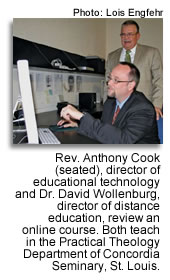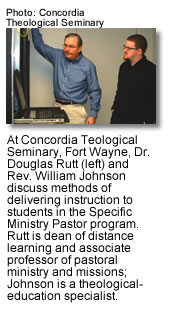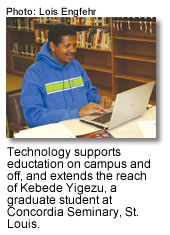by Roland Lovstad
As technology enables LCMS seminaries to broaden their reach through new and innovative ways to teach and learn, they are also giving careful attention to assure that technical advances also foster the goal of not just training, but forming, pastors for the mission of engaging the world with the Gospel of hope.
“It’s no longer about not using technology or the expense of technology,” observes Rev. Anthony Cook, director of education and technology at Concordia Seminary, St. Louis. “It’s simply about using technology in a creative way to advance the Gospel.”
Cook points out that today’s students—whether in the residence program on campus or in a “distance learning” program—rely on their computer and the Internet. Instead of poring over a book in the library, they may be using their computers to access the card catalog, find a theological journal article, or conduct other research. They may be viewing or reviewing a class lecture, discussing a Scripture text online with fellow students and professors, or turning in an assignment.
Developing New Ways of Teaching
 Professors also are developing new teaching methods to incorporate technology. For example, Cook, an assistant professor of practical theology, uses a collaborative Web site for his on-campus class on Lutheran confirmation. Each student writes one lesson and posts it on the site, where other students review and edit the content. “By the time we are done, they will have a full confirmation program they can use when they go to their first call,” Cook says.
Professors also are developing new teaching methods to incorporate technology. For example, Cook, an assistant professor of practical theology, uses a collaborative Web site for his on-campus class on Lutheran confirmation. Each student writes one lesson and posts it on the site, where other students review and edit the content. “By the time we are done, they will have a full confirmation program they can use when they go to their first call,” Cook says.
“In some situations, we are moving from a professor lecturing to a professor asking questions. Then students attack the questions and do the research under the professor’s guidance,” observes Rev. William Johnson, educational technology specialist at Concordia Theological Seminary, Fort Wayne. “Through their interactions they teach one another.”
“We’re finding new ways to share the same doctrines and communicate effectively in ways that traditional models didn’t necessarily do,” explains Johnson. He sees technology helping the Fort Wayne seminary further its new curriculum, which emphasizes interaction between faculty and students. “It’s a relational model; it’s not necessarily ‘Herr Professor’ any longer, but a professor who guides the students in the classroom and serves as a model of pastoral care for them.”
Using Distance Education
The church’s pressing need for pastors is spurring the use of technology for “distance education.” The process seeks to form pastors for rural and inner-city congregations and immigrant populations—locations unable to support a full-time pastor. Often, the locations are served under district supervision by a layman who has completed basic instruction in the Scriptures, Christian doctrine, and preaching and enters a program with a seminary. Active congregations also tap distance education to equip a staff member or a layman for ministries such as outreach to ethnic groups or church planting.
Dr. Douglas Rutt, dean for distance learning at Concordia, Fort Wayne, recalls his weekly routine 15 years ago in Latin America. He traveled around the country, leading three-hour evening classes at one location, then moving on to another—and the next.
“Technology makes it much richer,” he says. “Certainly, distances don’t have to be an obstacle.” He says technology also offers “dynamic tools” to connect students in all four corners of the United States into a virtual community.
The most efficient way to form pastors is for them to come to the seminary campus, says Dr. David Wollenburg, director of distance education at Concordia, St. Louis. “But,” he adds, “that would leave ministries without any pastoral care. In those instances the new distance-education opportunities for pastor formation may be appropriate.
“The seminary formation process in distance education is based upon the needs of the church, not an individual’s desire to be a pastor,” Wollenburg observes. Referring to the new Specific Ministry Pastor program (see the story in this issue), he adds, “The expectation is that these men will serve in the ministry where they are until they gain additional credentialing.”
A vital concern for both Rutt and Wollenburg is the development of community among professors and students so that technology helps to do more than teach, but helps form pastors.
Building Community
“You have to think differently,” Wollenburg says. “It could very easily happen that students feel separated from the faculty member.” In addition to traditional interactions through graded weekly journals and web-based discussions, professors at Concordia Seminary, St. Louis, encourage contact by offering weekly two-hour live sessions. “It’s a live meeting,” he adds, “Every student has to be equipped with speakers and a webcam.”
 At Fort Wayne, the faculty use online “discussion boards” and e-mail. Rutt notes that instructors employ learning strategies such as readings and assignments that involve students in small groups who work together virtually, using the Internet tools that are available to establish a sense of community.
At Fort Wayne, the faculty use online “discussion boards” and e-mail. Rutt notes that instructors employ learning strategies such as readings and assignments that involve students in small groups who work together virtually, using the Internet tools that are available to establish a sense of community.
“Learning takes place in a social context and therefore the interaction among the students is the key to it all,” Rutt observes. “It’s not so much in the use of fancy technology to deliver a piece of content, but it’s more in making it possible for students to interact— between themselves and with the professor.”
From experience with the Distance Education Leading to Ordination program, Wollenburg says the seminary has learned that distance-education students do build relationships. “They do get to know each other online. They pray for one another and with one another online, and they share their joys and sorrows.” He adds that distance students also build close rela-tionships to their local assigned pastor-mentor and the congregation in which they serve.
“Just because it’s distance, it doesn’t mean it comes easy,” Wollenburg says of the process. “Many students have a family, a job, and a vicarage or parish assignment while they are going to school, and these courses require at least as much personal time as do the residential courses.”
Reaching Beyond
 For almost two years Concordia Seminary, St. Louis, has placed courses—in video and audio formats—on iTunes U, a branch of the popular Web site for music downloads. The seminary gets thousands of downloads every week, according to Cook. “People are beginning to use them in different ways, like Bible class or pastors brushing up on their studies,” he says. The offerings include a full course of Greek.
For almost two years Concordia Seminary, St. Louis, has placed courses—in video and audio formats—on iTunes U, a branch of the popular Web site for music downloads. The seminary gets thousands of downloads every week, according to Cook. “People are beginning to use them in different ways, like Bible class or pastors brushing up on their studies,” he says. The offerings include a full course of Greek.
“I would love to have a computer in every congregation’s library, where a member can sit down and easily access content that is delivered to them from the seminary via the Internet,” he adds.
Johnson speaks about initiatives to make faculty and their expertise available to the whole church. “This is a time of ubiquitous information and ubiquitous disinformation,” he says. “It behooves us to provide a bastion of good solid teaching and authority that is available to God’s people at any place. It could be a marvelous time for the Gospel.”





